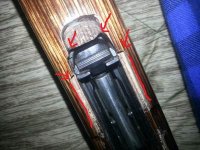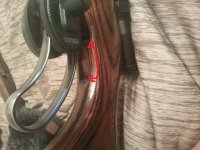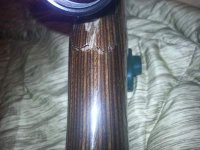dylanjbegin
Inactive
Hey guys, I have done some reading on this forum but created an account to ask for some advice here.
I ordered a stock from boyds on July 28 for a Winchester Model 88 late model in nutmeg. I recieved it within a week or two but was unable to fit the stock right away due to my work schedule as a wildfire fighter. Out of the box this stock was beautiful and I couldnt wait to get it on my rifle. However, getting the stock to fit proved somewhat difficult as the magazine would not properly fit without removing some wood. I assumed this was normal and got to work after reading that some minor alterations may be necessary to achieve proper fit. I then noticed that upon trying to close the action of the rifle (lever action), the area just behind the trigger would also need to be shaved down and in fact notched in order to properly close the action. This seemed like a substantial amount of wood removal but I again reread the statement saying some minor alterations may be necessary to achieve proper fit. Upon completing both of these tasks, I began applying coats of TRU oil and rubbing down with steel wool in between coats. I ended up applying 12 coats and the stock looked beautiful. I later put the rifle together and took it to the range for a few practice shots. After my second shot the stock cracked behind the barrel, making a mess of all my work and making me pretty upset. All bolts holding the rifle body to the stock were snugged up as to not over tighten, and the cracking occured after shots had been fired. I do not see any situation where this is not simply failure of the wood product they have sold me. I would ask for a replacement stock, but after putting over ten hours into fitting and oiling this stock and having it fail after two shots, I don't think i can justify doing so again. With work I simply don't have the time or energy. I personally feel I should be entitled to not only a refund of the stock price, but also my shipping costs as my total came out to $136.79 after shipping to Canada. I have pictures of all of the issues I had with the stock if you guys wouldnt mind taking a look see. Caution, images may be disturbing haha
You can see in the images where i have added a red line to show where i had to remove wood. The area behind the trigger is actually quite a significant amount of wood removed and i feel I should not have been responsible to do this simply to make the stock fit.
Im going to email boyds but cant find a customer service email address if anyone knows it tat would be great. I work during their buisness hours so am not really able to call them then.
Thanks in advance for any advice you have on dealing with them!
I ordered a stock from boyds on July 28 for a Winchester Model 88 late model in nutmeg. I recieved it within a week or two but was unable to fit the stock right away due to my work schedule as a wildfire fighter. Out of the box this stock was beautiful and I couldnt wait to get it on my rifle. However, getting the stock to fit proved somewhat difficult as the magazine would not properly fit without removing some wood. I assumed this was normal and got to work after reading that some minor alterations may be necessary to achieve proper fit. I then noticed that upon trying to close the action of the rifle (lever action), the area just behind the trigger would also need to be shaved down and in fact notched in order to properly close the action. This seemed like a substantial amount of wood removal but I again reread the statement saying some minor alterations may be necessary to achieve proper fit. Upon completing both of these tasks, I began applying coats of TRU oil and rubbing down with steel wool in between coats. I ended up applying 12 coats and the stock looked beautiful. I later put the rifle together and took it to the range for a few practice shots. After my second shot the stock cracked behind the barrel, making a mess of all my work and making me pretty upset. All bolts holding the rifle body to the stock were snugged up as to not over tighten, and the cracking occured after shots had been fired. I do not see any situation where this is not simply failure of the wood product they have sold me. I would ask for a replacement stock, but after putting over ten hours into fitting and oiling this stock and having it fail after two shots, I don't think i can justify doing so again. With work I simply don't have the time or energy. I personally feel I should be entitled to not only a refund of the stock price, but also my shipping costs as my total came out to $136.79 after shipping to Canada. I have pictures of all of the issues I had with the stock if you guys wouldnt mind taking a look see. Caution, images may be disturbing haha
You can see in the images where i have added a red line to show where i had to remove wood. The area behind the trigger is actually quite a significant amount of wood removed and i feel I should not have been responsible to do this simply to make the stock fit.
Im going to email boyds but cant find a customer service email address if anyone knows it tat would be great. I work during their buisness hours so am not really able to call them then.
Thanks in advance for any advice you have on dealing with them!



